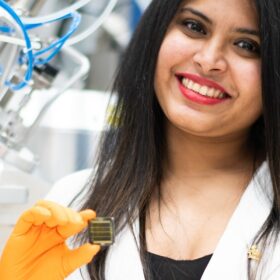Scientists propose manufacturing process to build perovskite solar cells on the Moon
German scientists believe that power generation for future habitats on the moon could be achieved by manufacturing halide perovskite cells locally, using regolith-based moonglass.
Agrivoltaics for radicchio
An Italian research team has found that radicchio seedlings grown in a lab-scale greenhouse with a perovskite solar PV roof exhibited faster growth and larger leaves than the bare glass reference. In addition, simulations of such a PV roof revealed a positive energy balance, satisfying the energy demands of a typical greenhouse located in Italy.
Australian researchers advance halide perovskite cell stabilization
University of Sydney researchers have suppressed ion migration at the B-site in halide perovskites, reducing energy loss and improving solar cell stability and performance reliability.
Alumina oxide nanoparticles extend perovskite solar cell lifetime
Scientists in the U.K. have used alumina oxide in perovskite solar cells to achieve lifetimes exceeding 1,300 h under standards-based heat and humidity testing. Their analysis showed that a reference cell based on conjugated polyelectrolytes degraded in one-tenth the time.
Chinese PV Industry Brief: Kelin Electric to raise funds for 1 GW perovskite project
Kelin Electric says it plans to raise up to CNY 1.46 billion ($201.8 million) through a private placement, with CNY 1.26 billion allocated for a 1 GW perovskite solar module project in Hangzhou, Zhejiang province.
Scientists unveil durable perovskite PV modules with carbon nanotube electrode
Japanese researchers have engineered a 100 cm² perovskite solar cell module featuring a robust single-walled carbon nanotube (CNT) electrode to improve durability and enable dual-sided light absorption.
Chinese PV Industry Brief: Aiko Solar wins 1 GW BC module bid in Datang tender
Aiko Solar has won a 1 GW back-contact (BC) module bid in China Datang Group’s 22.5 GW tender, while CNNC Photovoltaic announced a 19.7% efficiency rating for a perovskite module and plans to launch a perovskite production line later this year.
Gas quenching with helium, argon for more stable perovskite solar cells
Kuwait University researchers investigated the relationship between the molecular weight of the quenching gas and the morphology of perovskite films used in solar cells, finding that argon and helium extended device lifetimes compared to using the more conventional nitrogen.
Chinese scientists build 20.3%-efficient mini inverted perovskite solar modules via slot die coating
A team led by University of Electronic Science and Technology of China (UESTC) has found that pyrrodiazole as an additive in formamidinium iodide (FAI)-based inverted perovskite solar enables larger area devices made with industry-compatible slot die coating. Modules made using the technology achieved 20.3% certified power conversion efficiency and retained 94% of initial efficiency after 1,000 h in standard testing.
Power Roll developing 12.8%-efficient back-contact perovskite solar devices
Researchers from the U.K.’s University of Sheffield and Power Roll, a perovskite solar PV technology company, have achieved 12.8% power conversion efficiency in indium-free devices based on novel back-contact process. A slot-die coating process was demonstrated, compatible with roll-to-roll manufacturing.










